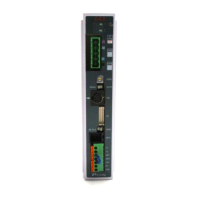41
5.2.1 Explanation of Signal Names
The following explains the signal names, and gives a function overview of each signal.
In the explanation of operation timings provided in a later section, each signal is referenced by its self-
explanatory name for clarity. If necessary, however, such as when marker tubes are inserted as a
termination of the flat cable, use the signal abbreviations.
PIO pattern = 0: Positioning mode [Standard type]
Category Signal name
Signal
abbreviation
Function overview
PC1
PC2
PC4
PC8
PC16
Command position
number
PC32
The target position number is input.
A command position number must be specified by 6 ms before the
start signal (CSTR) turns ON.
Brake release BKRL
This signal is used on an actuator equipped with a brake to forcibly
release the brake.
Operating mode RMDO
This signal switches the operating mode between AUTO and MANU.
Home return HOME
Home return operation is started at a rise edge of this signal.
*Pause *STP
ON: Actuator can be moved, OFF: Actuator decelerates to a stop
Start CSTR
The actuator will start moving at a rise edge of this signal.
Alarm reset RES
An alarm is reset at a rise edge of this signal.
Input
Servo ON SON
The servo remains ON while this signal is ON.
The servo remains OFF while this signal is OFF.
PM1
PM2
PM4
PM8
PM16
Completed position
number
PM32
The relevant position number is output when positioning has
completed.
The signal will turn OFF when the next start signal is received.
It is used by the PLC to check if the commanded position has
definitively been reached, and also to provide a position interlock, etc.
Moving MOVE
This signal will remain ON while the actuator is moving, and OFF
while the actuator is standing still.
It is used to determine whether the actuator is moving or paused.
Zone ZONE1
This signal becomes effective after home return. It will turn ON when
the current actuator position enters the range set by the parameters
and remain ON until the actuator exits the range.
Position zone PZONE
This signal becomes effective after a position movement command is
input. It will turn ON when the current actuator position enters the
range specified in the position table and remain ON until the actuator
exits the range.
Operating mode status RMDS
This signal will remain OFF during the AUTO mode, and ON during
the MANU mode.
Home return
completion
HEND
This signal is OFF immediately after the power is input, and turns ON
when home return has completed.
Position complete PEND
This signal turns ON when the target position was reached and the
actuator has entered the specified in-position range.
It is used to determine whether positioning has completed.
Ready SV
This signal is always output once the servo is turned ON and the
controller is ready to operate.
*Emergency stop *EMGS
When this signal is OFF, it means that an emergency stop is being
actuated.
*Alarm *ALM
This signal remains ON in normal conditions of use and turns OFF
when an alarm generates.
Load output judgment
status
LOAD
This signal will turn ON when the command torque exceeds the
threshold while the actuator is inside the check range.
Note) Dedicated output signal for the PCON-CF
Output
Torque level status TRQS
This signal will turn ON when the motor current reaches the
threshold.
Note) Dedicated output signal for the PCON-CF

